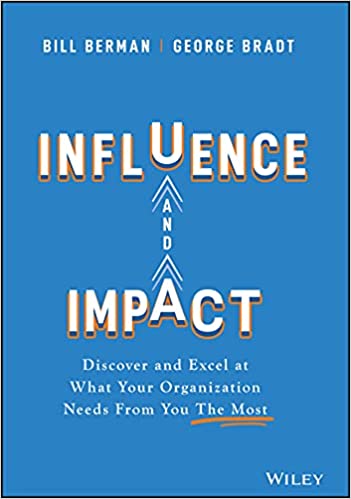Today on the Atlanta Small Business Show, we’re pleased to welcome back Bill Berman, executive coach, founder of Berman Leadership Development, and the author of Influence and Impact. Berman is a seasoned consultant with more than 30 years of experience and has consulted executives and C-suite business leaders. In this segment, Berman discusses how to build influence with managers and executives at the top of the company.
Jim Fitzpatrick :
So Bill, thanks so much for joining us once again on the show.
Bill Berman:
Great to be back again. Thanks very much.
Jim Fitzpatrick :
Sure. So this notion of influencing from the top, from those at the top, very important topic these days. We’re all looking and we want our leaders to be leaders. Right? And we want to be led through times like this. So talk to us about that. What’s the importance of influencing those at the top and those who have no formal authority?
Bill Berman:
So when you think about the job of an executive or somebody in a C Suite, particularly of a publicly traded company, but even private equity held or closely held companies, they have a million things to be thinking about all at the same time. They’re thinking about how am I supposed to deliver value? How am I going to acquire the value? How am I going to design my organization? Who are the people who are going to be doing the work here? Where do I allocate my resources? All of those questions are always on their mind. And so when getting them to think about what you want them to think about it and getting them to think about it the way you want to think about it is not a trivial task. My experience and my clients’ experiences that if you don’t do it right, you can easily find yourself going down a rabbit hole with one of these executives who grab onto something and then just sort of zero in on it. And you really want to avoid that. That’s when you get in trouble.
Jim Fitzpatrick :
That’s right. That’s right. Can you share a few strategies to build influence with management?
Bill Berman:
Absolutely. We talk about in the book is there are three foundational elements to influence. So you have to have expertise. You have to be able to deliver every single time. So consistent execution on your strategy and you have to be able to communicate effectively. Right? Those are the three core elements. And once you’ve got those nailed down, then you’re probably starting to deal with people much more senior than you, whether it’s a general manager or a C Suite sure.
Then the number one key, the there’s standard advice, which is be be brief, be bright, be gone. And that’s kind of right, but it’s kind of not. So you want to focus on, what’s the quality of the message? What is it you’re trying to tell them? What is the key thing you want them to think about? Executives are geared toward decision making, right? Because they have to make 20 decisions a day. And it’s usually, do I fund this? Do I not? Do I hire this person? Do I not? Do I change the budget? Do I leave it alone? And so what is the story you want? What is the message you want them to get, and what is the decision you want them to make? And be really clear and focused about that.
The second piece is, what is it that they want to know? One of the most common mistakes I see around seeing executives at pretty senior levels is they feel a need to tell senior executives, let me tell you all the things I did to figure this out before I tell you what I found. They go into great detail partly because they’re afraid that the executive is going to say, “Well, how do you know that? How do you know that? How do you know that?” But the answer is tell them what you want. Tell them the end of the story first and then tell them why you think that’s the case and let them take you. There’s nothing wrong with an executive saying, “How do you know that?” Then your answer should be, “That’s a really good question. Let me tell you about that.”
Jim Fitzpatrick :
That’s a great point.
Bill Berman:
But you don’t start with that. You start with, here’s the question I need you to answer, and here’s what we think is the recommendation. And here are your options. The third piece is think like an executive. Right? What’s the big picture? What’s the downstream consequences? So you’re thinking about, how do I get this project done by the end of the year? They’re thinking about, what is that project going to mean for our branding in two years, and what’s it going to tell our investors at the next quarterly meeting? Right. Those are the questions they’re thinking about. So if you haven’t thought about that at all, you’re not going to be helpful to them. And so fundamentally you have to remember, you’re there to help them do their job. It’s not really that they’re there to help you do your job. So if you help them do their job, which is sell the business, lead the company, drive growth, drive results. Then you’re going to be much more successful.
Jim Fitzpatrick :
That’s right. That’s right. Any special skills that you feel is needed to be successful in this?
Bill Berman:
Storytelling, storytelling.
Jim Fitzpatrick :
Storytelling.
Bill Berman:
You got to be a good storyteller. And I don’t don’t mean like woe begone 15 minute prolonged discussions. But being able to know what’s the key message and how to tell, how to explain it to them in a way that they hear it quickly and clearly. It’s all about storytelling. The other piece of that is you have to remember people make decisions. They justify decisions based on data. But a lot of times, they make decisions based on emotion. And does it feel right? Does it ring true? Does this sound right to me? And then they look for the data to support that. So you want to be able to hit not just the head, but you want to hit their heart as well.
Jim Fitzpatrick :
Right. Right. I’ve got two managers.
Bill Berman:
That’s all about storytelling.
Jim Fitzpatrick :
That’s right. I’ve got two managers, two different types of managers that work for me where one, the first manager will come in and start to tell me their story or the situation that I’ve got to address or what have you. And as a typical A personality and executive, I’m stopping them all the way through. “Well, what about this? Well, what about that? Well, what happens then? Well, what’s the time on that?” And they’re jumping all around and they’re busy answering my questions.
The other manager walks in and says, “Jim, I need 10 minutes of your time. Let me go through the entire scenario. And I’ll answer any questions that you might have at the end.” Hey, I don’t even remember some of the questions I was going to ask, and maybe they were answered through his presentation or her presentation. And I always, I think to myself, that’s a great way to come into my office and either ask for direction or help or money or whatever the case might be, because it gives that individual that opportunity to roll out the entire story to say, here it is. And here’s the result or here’s the remedy that I’ve come up with. Did you have any questions? And of course, I may have a question or two. But do you find that one works over the other?
Bill Berman:
Absolutely. That second person that who works for you is dead on. That’s exactly what you need to be doing. Years ago, when I was running a software company, I had a head of support who would come into my office to say, “I don’t know what we’re going to do. We don’t have enough staff to handle all the support calls.” And I’d say, “Okay, what do you want to do about it?” He’d be like, “I don’t know. What do you think I should do?” I’m like, “I think you should go away and figure out what you want to do about it and come back and talk to me about it.”
Jim Fitzpatrick :
Right. That’s right. That’s right.
Bill Berman:
He ended up not working out because he couldn’t do it. He just wouldn’t do it. So you want to come to executives with solutions and alternatives.
Jim Fitzpatrick :
That’s right.
Bill Berman:
And you have to know the kind of organization you work with, because in some organizations, the CEO is going to say to you, “If that’s what you think you should do, go do it.” And others they’re going to say, “Well, what are my alternatives? What else should I do? Why don’t you do C?” And so you have to know whether they’ve really given you the power to make decisions and take action, or whether they’re looking for you to make recommendations so that they can decide what the right thing to do is. It’s not across the board. Some different situations require different things. But if you think you’re empowered to make a decision and they just want recommendations, you’re going to really get to loggerheads with them.
Jim Fitzpatrick :
That’s right. That’s right. And if they’re giving you as a manager, if they’re giving you, if the executive is giving you alternatives or options or did you think about this? It doesn’t mean you’re wrong. It doesn’t mean you’re going to be fired at the end of the day because you didn’t come up with those ideas or solutions. Right? It just means it’s the style of that executive to say, “I want to have input in this particular issue that you’ve come in with.” Right?
Bill Berman:
Yep. I see a lot of middle management and VP, senior VP even who think that they should have complete autonomy to do whatever they want without vetting it with their managers. And most of the time the managers, they want to know that you’ve thought it through and that you’ve considered alternatives, and that your plan is a data based plan. They’re not trying to tell you what to do necessarily, but people get very … get their backs up when a manager starts asking what I call micro interest questions, and think that you should leave me alone to do what I know how to do. Well, yes. Maybe no. There’s a lot of money riding on this.
Jim Fitzpatrick :
That’s right. That’s right. And I’m one of those type that go in and say, well walk me through that. How did you arrive at picking that particular decision or going in that particular direction? And you’re right. Some of the people that work for me, “What’s going on? Did you want me to run everything by you? You’re going to let me do my job.” And of course it’s not always the best case scenario for me, because I want to be brought in at some level to say, “Hey, here’s the issue, and here’s what I’m going to do and great, keep doing it.” But when I do have those people that just continue to do their own thing and they never darken my doorway as the owner of the company, it builds a concern like, that’s kind of interesting. I’m not brought in on anything and yet they keep going. Right?
Bill Berman:
Absolutely. If you’ve known somebody for five, six, 10 years and you know what they’re going to do and you know how they operate, of course you’re going to step back and pull back. Where I see it being a problem is when a new manager comes in to somebody who’s been in the job for two, three years, but I don’t know them from Adam.
Jim Fitzpatrick :
That’s right.
Bill Berman:
And so of course I’m going to ask questions, but they’re like, “What do you think, I don’t know how to do my job?” No, I don’t know how to do your job. I want to learn how to do your job.
Jim Fitzpatrick :
That’s right. That’s right. Just want to be brought in the loop. Right?
Bill Berman:
Absolutely.
Jim Fitzpatrick :
From your perspective, we talked a little bit about it before we got recording today. But this COVID situation is somewhat in the rear view mirror, not completely done but how is that … And this is a loaded question, I know. But how has that impacted leadership of companies and how they work, how they work at the executive level to make these decisions each and every day and to influence each other? Is it a whole new book because we’re now in a post-COVID world with so many things that have come out of it, such as remote environments and remote working and things like that?
Bill Berman:
I think that the decision making that they have to do hasn’t changed. In fact, if anything, it’s accelerated. But I think what’s happened is that there’s been a shift in the balance of power in a lot of organizations. If you go back even 10 years, employees didn’t have a huge impact on how a business made decisions or what sort of stands they took around things. Now more and more organizations are finding that they have to have opinions, they have to take stands. They have to have a view of how we think about issues around human rights, around issues around climate, around individual liberties, all of those kinds of things, because the balance of power has shifted to the employee. And it’s more of a buyer’s market in terms of employees than it is a seller’s market.
I mean, if we ended up back at eight, 9% on unemployment, that may shift back again. But right now, you’ve got to think about your employees and the employee experience. And you’ve got to think about your customers and what their experience of you is because they have a lot of choices. They’ve got to think they can decide to go somewhere else. And there are a lot more people in the rear view mirror coming up on your business than you think there is. So if you think you’ve got a special corner on the market, just start looking in your rear view mirror.
Jim Fitzpatrick :
That’s exactly right. Times have changed in that regard. And of course these little things haven’t … I shouldn’t say haven’t helped any, but I guess they actually have helped many businesses to grow. But everyone now if they want to be able to pick up their phone or their iPad, or what have you and say, “I’m going to do business, I’m going to engage with this business digitally.” And sometimes you don’t even get an opportunity to meet anybody at the company anymore. Right? And it’s just-
Bill Berman:
No, you don’t. And it still matters. I’ve seen a huge growth in the number of off-sites that we’ve been conducting, in person off-sites over the past couple of months. And it’s going to continue into the rest of the summer in the fall, because people are dying to get back together. I keep hearing, “I’m working with a team and half the people I’ve never met in person. And I just want to get to know these people.” And which tells you that even though the video thing tends to work pretty well, it’s not the same thing.
Jim Fitzpatrick :
That’s right.
Bill Berman:
And we still know it’s not the same thing.
Jim Fitzpatrick :
That’s right. That’s right. I do not know how companies are building great cultures for their companies within their companies on a remote basis. It seems to me to be so difficult. It was difficult for us to run our media company through COVID and we had so many people working remotely and you just lost so much of that interaction with your team. That really, I think at the end of the day, culture takes a hit on that. Right?
Bill Berman:
Absolutely. Absolutely. Culture. You can get the work done remotely, but building a culture and building an experience really requires some kind of in person contact. So you’ve got to build that, and that’s going to have to get bill back into the budgets, and it’s largely gone over the past two years.
Jim Fitzpatrick :
That’s right. That’s right. No question about it. Bill Berman, executive coach, author, founder of Berman Leadership Development. Check this gentleman out online. We’re going to make it very easy for you to get the book, because there’s going to be a link right underneath this video. Do yourself a favor. It’s a phenomenal book, Influence and Impact. So we want to help. I want to thank you very much, Bill for joining us on the show today.
Bill Berman:
Jim, it’s great to see you. I’m always happy to be here.
Jim Fitzpatrick :
Great. Thanks.
The Atlanta Small Business Network, from start-up to success, we are your go-to resource for small business news, expert advice, information, and event coverage.
While you’re here, don’t forget to subscribe to our email newsletter for all the latest business news know-how from Atlanta Small Business Network.








